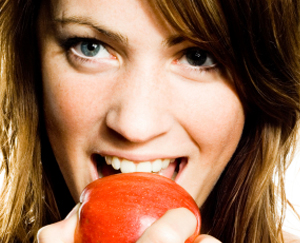Your Best Organic Bets

When considering your produce, remember that nine out of ten Americans do not eat the recommended 2 portions of fruit and 2 1/2 portions of vegetables each day. So, your first step might be to simply incorporate more fruits and vegetables into your diet. However, with all the headlines about pesticides, hormones, antibiotics, and other food-safety issues, many people are considering organic options more often.
While more research is needed for confirmation, “some evidence suggests that organic produce may contain more vitamins, minerals, and other beneficial plant compounds than conventionally grown produce,” says Dawn Jackson Blatner, RD, the national media spokesperson for the American Dietetic Association in Chicago. In any case, in addition to the advantage of lower pesticide levels, organically grown producs is also Earth-friendly: sustainable organic farming enhances the soil and conserves water—a boon to all of us in the long term.
Get to know the top 12
Since organics often cost more to produce and therefore may cost shoppers more, those not up to buying organic everything can still benefit their families’ health by concentrating on where they get the most bang for the buck.
The Environmental Working Group—a Washington DC-based watchdog organization of scientists, policy experts, lawyers, and other professionals who review studies and data to expose threats to our environment and health—has compiled a list based on extensive analysis on contaminants in produce. The EWG claims you can lower your pesticide exposure by choosing the organic varieties of the following fruits and vegetables—presented from most to least important.
- Strawberries
- Spinach
- Nectarines
- Apples
- Peaches
- Pears
- Cherries
- Grapes
- Celery
- Tomatoes
- Sweet bell peppers
- Potatoes
You can start slowly and purchase just a few items each week. Make one out of every ten foods you buy organic. Pick one thing—strawberries, spinach, or potatoes, for instance. Environmentalists and health professionals agree: if we can get a lot of people to do a little, it will make a big difference!
15 low-risk favorites
The produce in this list does not appear to absorb pesticides as easily and is safer to consume in non-organic form, including:
- Sweet corn
- Avocados
- Pineapples
- Cabbage
- Onions
- Sweet peas (frozen)
- Papyas
- Asparagus
- Mangos
- Eggplant
- Honeydew melon
- Kiwi
- Cantaloupe
- Cauliflower
- Grapefruit
Remember, the important thing is to get what fruits and veggies you can into your home. If they're within reach—such as in your fridge or in a fruit bowl on the dining room table—you’re more likely to eat more. And eating more fruits and vegetables may well be more important to your health bottom line than avoiding pesticides. Counsels Blatner, “Consume the minimum recommended amount every day—no matter how it’s grown!”
Copyright © 2025 TraceGains, Inc. All rights reserved.
